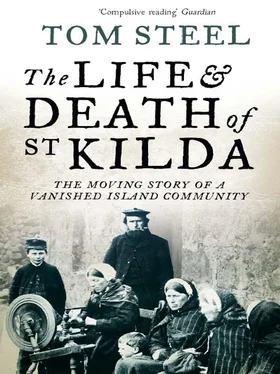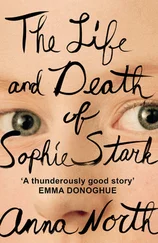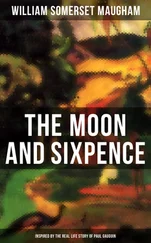1 ...6 7 8 10 11 12 ...22 Born in 1825, Ewen spent all his childhood on the island, and when the time came to settle down he married the daughter of one of the elders. At the age of twenty-six he decided to leave the island and seek his fortune in Australia. He sold up his croft, furniture, and unwanted effects for £17, and with his young bride decided to go to Australia, where he was first employed as a brickmaker.
After six months he became bored, left his job and took to travelling. For two years he explored the virgin lands of Victoria digging for gold. He had luck and bought himself a farm. Owing to a lack of capital the farm proved an unwise investment, and within two years he was off to New Zealand to dig again for gold, leaving his wife and children at Melbourne. In less than two years he was back again in Australia to find that his wife, thinking she had seen the last of him, had married someone else. Disillusioned but not dismayed, Ewen packed his bags and sailed for North America.
Like many penniless immigrants, Ewen Gillies joined the Union Army. After getting some money together he deserted the ranks when word got round that gold was to be found in California. For six years he worked in the gold mines with considerable success. With his fortune, he decided to return to Australia and claim his children. Reluctantly, his wife finally agreed to surrender them, and not wishing to stay in Australia any longer than was necessary, Ewen packed up his belongings and set sail in 1871 via London and Glasgow for St Kilda. He was welcomed enthusiastically by the islanders, but to a man who had been round the world St Kilda offered little, and after only four weeks Ewen and his children set sail for America.
Eleven years later, after he had settled his family in the New World, Ewen again found the call of St Kilda too strong to resist. Yet again, he set out for the isle of his birth. This time he proved too much for the St Kildans, and after a short stay he found himself no longer welcome on the island and set sail once again for Melbourne. He had, however, stayed long enough on St Kilda to fall in love with a local girl. His second bride found the Australian climate little to her liking and was homesick. Eight months later the couple were again on St Kilda.
The St Kildans, distrustful of his wisdom and overpowering self-assurance, finally forced him and his wife to leave. Ewen boarded the first boat to reach St Kilda in the summer of 1889, and made his way to Canada where he spent the remainder of his life.
The hospitality of the people of Hirta, however, was normally something that visitors could not easily forget. ‘The people’, wrote a former schoolmaster, ‘were exceedingly kind to me, quite a different character they had to what was presented to me on landing. One has to stay some time amongst them to know them thoroughly.’ Nor was their concern confined to those who chose to live amongst them.
The St Kildans frequently had to play hosts to unfortunates who found themselves stranded on the island. On 17 January 1876, some of the crew of the 880-ton Austrian ship Peti Dubrovacki were shipwrecked. Three of the crew, including the captain, stayed with the minister while they were on the island. The remaining six were quartered with the islanders, each home taking in a man or two by turns for a few days at a time. The St Kildans showed themselves to be generous to those in distress. ‘I myself’, wrote Sands, ‘saw a man take a new jacket out of the box into which it had been carefully folded, and with a look of genuine pity, gave it to the mate to wear during his stay, as the young man sat shivering in an oilskin.’ The St Kildans had not only studied the parable of the Good Samaritan, but throughout history followed it. A people used to deprivation, they could feel for those forced to accept the same condition. But nine sailors were additions the people could scarce afford to feed. It was mid-winter and the owner’s boat was not expected until the spring. John Sands realized that contact with the mainland must somehow be made before the St Kildans as well as their uninvited guests starved.
Sands first got an idea when he observed that the St Kildans used reeds in their looms. He was told that they were salvaged from the beach, and deduced that the currents of the Atlantic, namely the Gulf Stream, must have brought them to Hirta. He decided that the same currents could be used to send a letter from St Kilda to the mainland. In January 1877 he set about constructing a vessel to convey a message that would inform the mainland of the existence of the band of shipwrecked Austrians.
‘On the 29th, the captain and sailors called on me and felt interested in seeing a canoe I had hewn out of a log,’ wrote Sands. ‘I had written a letter and put it into her hold, enclosed in a pickle bottle. The sailors, glad of anything in the shape of work, helped me to rig her and put the iron ballast right, and to caulk the deck. We delayed launching her until the wind should blow from the North-West, which we hoped would carry her to Uist or some other place where there was a post. A small sail was put on her, and with a hot iron I printed on her deck, “Open this”.
‘The captain brought me a lifebuoy belonging to the lost ship, and said he intended to send it off. I suggested that another bottle be tied to it with a note enclosed to the Austrian Consul, and that a small sail should be erected. This was done and the lifebuoy was thrown into the sea and went away slowly before the wind. None of us had much hope that this circular vessel would be of service. She was despatched on the 30th and strange to say, reached Birsay in Orkney, and was forwarded to Lloyd’s agent in Stromness on 8 February, having performed the passage in nine days.
‘On 5 February we sent off the canoe, the wind being in the North-West and continuing so for some days. She went to Poolewe in Ross-shire where she was found lying on a sandbank on the 27th by a Mr John Mackenzie who posted the letter.’
In fact, it was the first mailboat that was to bring help. On 22 February HMS Jackal arrived at St Kilda and took the nine Austrians and John Sands back to the mainland. By that time, the St Kildans had already given up eating porridge and bread. This continued for three months, until the factor’s smack visited the island and took grain, sugar, tea, salt, and other foodstuffs to them. The foodstuffs were paid for out of a donation of £100, made by the Austrian Government to the people of Hirta in recognition of their kindness.
The St Kildans were greatly amazed by such a crude method of communication as the mailboat of John Sands. It was thenceforth thought a useful way in which contact could be made with the mainland. The earlier mailboats were usually of a common construction; each consisted of a piece of driftwood, the centre of which was hewn out sufficiently to hold a letter and some money for postage, and then sealed with pitch. In later models, an inflated sheep’s bladder was attached to the block of wood, together with a rude flag to make the mailboat more conspicuous at sea.
Around 1900, cocoa became popular on Hirta. Instead of wood, an eight-ounce tin that once contained Van Houten’s chocolate was thought to be an admirable carrier of a message. The mailboats, with a penny enclosed for postage, were normally put out to sea from the rocks of Oiseval and, depending upon the North Atlantic Drift, occasionally turned up as far away as Norway. They were used by the St Kildans as a last resort in times of emergency, but more often than not as tourist attractions.
To the end, mailboats were a romanticism introduced to St Kilda by people from the mainland. The islanders preferred their age-old method of attracting attention if faced with a problem. Bonfires were lit on the hilltops, which in clear weather could be seen on the horizon by the inhabitants of Lewis or Harris.
Читать дальше












